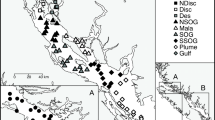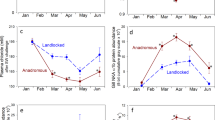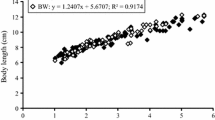Abstract
Maturing adult sockeye salmon Oncorhynchus nerka were intercepted while migrating in the ocean and upstream in freshwater over a combined distance of more than 1,300 km to determine physiological and endocrine changes associated with ionoregulation. Sockeye migrating through seawater and freshwater showed consistent declines in gill Na+/K+-ATPase (NKA) activity, plasma osmolality and plasma chloride concentration. In contrast, plasma sodium concentration became elevated in seawater as fish approached the river mouth and was then restored after sockeye entered the river. Accompanying the movement from seawater to freshwater was a significant increase in mRNA for the NKA α1a subunit in the gill, with little change in the α1b subunit. Potential endocrine signals stimulating the physiological changes during migration were assessed by measuring plasma cortisol and prolactin (Prl) concentrations and quantifying mRNA extracted from the gill for glucocorticoid receptors 1 and 2 (GR1 and GR2), mineralocorticoid receptor (MR), growth hormone 1 receptor (GH1R), and prolactin receptor (PrlR). Plasma cortisol and prolactin concentrations were high in seawater suggesting a preparatory endocrine signal before freshwater entry. Generally, the mRNA expression for GR1, GR2 and MR declined during migration, most notably after fish entered freshwater. In contrast, PrlR mRNA increased throughout migration, particularly as sockeye approached the spawning grounds. A highly significant association existed between gill PrlR mRNA and gill NKA α1a mRNA. GH1R mRNA also increased significantly, but only after sockeye had migrated beyond tidal influence in the river and then again just before the fish reached the spawning grounds. These findings suggest that cortisol and prolactin stimulate ionoregulation in the gill as sockeye salmon adapt to freshwater.







Similar content being viewed by others
References
Andersen O, Skibeli V, Haug E, Gautvik KM (1991) Serum prolactin and sex steroids in Atlantic salmon (Salmo salar) during sexual maturation. Aquaculture 95:169–178
Beacham TD, Lapointe M, Candy JR, McIntosh B, MacConnachie C, Tabata A, Kaukinen K, Deng L, Miller KM, Withler RE (2004) Stock identification of Fraser River sockeye salmon using microsatellites and major histocompatibility complex variation. Trans Am Fish Soc 133:1117–1137
Björnsson BTh (1997) The biology of salmon growth hormone: from daylight to dominance. Fish Physiol Biochem 17:9–24
Blackburn J, Clarke WC (1987) Revised procedure for the 24 hour seawater challenge test to measure seawater adaptability of juvenile salmonids. Can Tech Report Fish Aquat Sci 1515:35
Brauner CJ, Shrimpton JM, Randall DJ (1992) The effect of short duration seawater exposure on plasma ion concentrations and swimming performance in coho salmon (Oncorhynchus kisutch). Can J Fish Aquat Sci 49:2399–2405
Bury NR, Sturm A, Le Rouzic P, Lethimonier C, Ducouret B, Guiguen Y, Robinson-Rechavi M, Laudet V, Rafestin-Oblin ME, Prunet P (2003) Evidence for two distinct functional glucocorticoid receptors in teleost fish. J Mol Endocrinol 31:141–156
Bystriansky JS, Frick NT, Richards JG, Schulte PM, Ballantye JS (2007) Wild Arctic char (Salvelinus alpinus) upregulate gill Na+/K+-ATPase during freshwater migration. Phys Bioc Zool 80:270–282
Carey JB, McCormick SD (1998) Atlantic salmon smolts are more responsive to handling and confinement stress than parr. Aquaculture 168:237–253
Carruth LL, Dores RM, Maldonado TA, Norris DO, Ruth T, Jones RE (2000) Elevation of plasma cortisol during the spawning migration of landlocked kokanee salmon (Oncorhynchus nerka kennerlyi). Comp Bioc Phys C 127:123–131
Colombe L, Fostier A, Bury N, Pakdel F, Guiguen Y (2000) A mineralocorticoid-like receptor in the rainbow trout, Oncorhynchus mykiss: cloning and characterization of its steroid binding domain. Steroids 65:319–328
Cooke SJ, Hinch SG, Crossin GT, Patterson DA, English KK, Healey MC, Shrimpton JM, Van der Kraak G, Farrell AP (2006a) Mechanistic basis of individual mortality in Pacific salmon during spawning migrations. Ecology 87:1575–1586
Cooke SJ, Hinch SG, Crossin GT, Patterson DA, English KK, Shrimpton JM, Van Der Kraak G, Farrell AP (2006b) Physiology of individual late-run Fraser river sockeye salmon (Oncorhyncus nerka) sampled in the ocean correlates with fate during spawning migration. Can J Fish Aquat Sci 63:1469–1480
Crossin GT, Hinch SG, Cooke SJ, Cooperman MS, Patterson DA, Welch DW, Hanson KC, Olsson I, English KK, Farrell AP (2009) Mechanisms influencing the timing and success of reproductive migration in a capital breeding semelparous fish species, the sockeye salmon. Phys Bioc Zool 82:635–652
Dingle H (1980) Ecology an evolution of migration. In: Gauthreaux SA (ed) Animal migration, orientation, and navigation. Academic Press, New York, pp 1–101
Donaldson EM, Fagerlund UHM (1970) Effect of sexual maturation and gonadectomy at sexual maturity on cortisol secretion rate in sockeye salmon (Oncorhynchus nerka). J Fish Res Board Can 27:2287–2296
Ducouret B, Tujague M, Ashraf J, Mouchel N, Servel N, Valotaire Y, Thompson EB (1995) Cloning of a teleost fish glucocorticoid receptor shows that it contains a deoxyribonucleic acid-binding domain different from that of mammals. Endocrinology 136:3774–3783
Hanson KC, Cooke SJ, Hinch SG, Crossin GT, Patterson DA, English KK, Donaldson MR, Shrimpton JM, Van Der Kraak G, Farrell AP (2008) Individual variation in migration speed of upriver-migrating sockeye salmon in the Fraser River in relation to their physiological and energetic status at marine approach. Phys Biochem Zool 81:255–268
Hinch SG, Cooke S, Healey MC, Farrell AP (2006) Behavioural Physiology of Fish Migrations: salmon as a model approach pp. 239–295, In: Sloman K, Balshine S, Wilson R (eds) Fish physiology, vol 24, Behaviour and Physiology of Fish, Elsevier Press
Hirano T, Prunet P, Kawauchi H, Takahashi A, Ogasawara T, Kubota J, Nishioka RS, Bern HA, Takada K, Ishii S (1985) Development and validation of a salmon prolactin radioimmunoassay. Gen Comp Endocrinol 59:266–276
Kiilerich P, Kristiansen K, Madsen SS (2007) Hormone receptors in gill of smolting Atlantic salmon, Salmo salar: expression of growth hormone, prolactin, mineralocorticoid and glucocorticoid receptors and 11β-hydroxysteroid dehydrogenase type 2. J Endocrinol 152:295–303
Laurent P, Perry SF (1990) Effects of cortisol on gill chloride cell morphology and ionic uptake in the freshwater trout, Salmo gairdneri. Cell Tissue Res 259:429–442
Livak KJ, Schmittgen TD (2001) Analysis of relative gene expression data using real-time quantitative PCR and the 2−ΔΔCt method. Methods 25:402–408
Madsen SS, Killerich P, Tipsmark CK (2008) Multiplicity of expression on Na+, K+-ATPase α-subunit isoforms in the gill of Atlantic salmon (Salmo salar): cellular localization and absolute quantification in response to salinity change. J Exp Biol 212:78–88
Manzon L (2002) The role of prolactin in fish osmoregulation: a review. Gen Comp Endocrinol 125:291–310
Marshall WS (2002) Na+, Cl−, Ca2+ and Zn2+ transport by fish gills: retrospective review and prospective synthesis. J Exp Zool 293:264–283
McCormick SD (1993) Methods for nonlethal gill biopsy and measurements of Na+/K+-ATPase activity. Can J Fish Aquat Sci 50:656–658
McCormick SD (2001) Endocrine control of osmoregulation in teleost fish. Am Zool 41:781–794
McCormick SD, Regish A, O’Dea MF, Shrimpton JM (2008) Are we missing a mineralocorticoid in teleost fish? Effects of cortisol, deoxycorticosterone and aldosterone on osmoregulation, gill Na+, K+-ATPase activity and isoform mRNA levels in Atlantic salmon. Gen Comp Endocrinol 157:35–40
McCormick SD, Regish AM, Christensen AK (2009) Distinct freshwater and seawater isoforms of Na+/K+-ATPase in gill chloride cells of Atlantic salmon. J Exp Biol 212:3994–4001
Mommsen TP, French CJ, Hochachka PW (1980) Sites and patterns of protein and amino acid utilization during the spawning migration of salmon. Can J Zool 58:1785–1799
Onuma T, Kitahashi T, Taniyama S, Saito D, Ando H, Urano A (2003) Changes in expression of genes encoding gonadotropin subunits and growth hormone/prolactin/somatolactin family hormones during final migration and freshwater adaptation in prespawning chum salmon. Endocrine 20:23–33
Onuma TA, Ban M, Makino K, Katsumata H, Hu WW, Ando H, Fukuwaka M, Azumaya T, Urano A (2010) Changes in gene expression for GH/PRL/SL family hormones in the pituitaries of homing chum salmon during ocean migration through upstream migration. Gen Comp Endocrinol 166:537–548
Richards JG, Semple JW, Bystriansky JS, Schulte PM (2003) Na+/K+-ATPase α-isoform switching in gills of rainbow trout (Oncorhynchus mykiss) during salinity transfer. J Exp Biol 206:4475–4486
Sakamoto T, Iwata M, Hirano T (1991) Kinetic studies of growth hormone and prolactin during adaptation of coho salmon, Oncorhynchus kisutch, to different salinities. Gen Comp Endocrinol 82:184–191
Sathiyaa R, Vijayan MM (2003) Autoregulation of glucocorticoid receptor by cortisol in rainbow trout hepatocytes. Am J Phys - Cell Phys 284:C1508–C1515
Shrimpton JM, Bernier NJ, Iwama GK, Randall DJ (1994) Differences in measurements of smolt development between wild and hatchery-reared juvenile coho salmon (Oncorhynchus kisutch) before and after saltwater exposure. Can J Fish Aquat Sci 51:2170–2178
Shrimpton JM, Björnsson BTh, McCormick SD (2000) Can Atlantic salmon smolt twice? Endocrine and biochemical changes during smolting. Can J Fish Aquat Sci 57:1969–1976
Shrimpton JM, McCormick SD (1999) Responsiveness of gill Na+/K+-ATPase to cortisol is related to gill corticosteroid receptor concentration in juvenile rainbow trout. J Exp Biol 202:987–995
Shrimpton JM, Patterson DA, Richards JG, Cooke SJ, Schulte PM, Hinch SG, Farrell AP (2005) Ionoregulatory changes in different populations of maturing sockeye salmon Oncorhynchus nerka during ocean and river migration. J Exp Biol 208:4069–4078
Shrimpton JM, Zydlewski JD, McCormick SD (2001) The stress response of juvenile American shad to handling and confinement is greater during migration in fresh water than in seawater. Trans Am Fish Soc 130:1203–1210
Sumpter JP, Dye HM, Benfey TJ (1986) The effects of stress on plasma ACTH, α-MSH and cortisol levels in salmonid fishes. Gen Comp Endocrinol 62:377–385
Tang Y, Lin H, Randall DJ (1992) Compartmental distributions of carbon dioxide and ammonia in rainbow trout at rest and following exercise, and the effect of bicarbonate infusion. J Exp Biol 169:235–249
Tipsmark CK, Madsen SS (2009) Distinct hormonal regulation of Na+, K+-atpase genes in the gill of Atlantic salmon (Salmo salar L.). J Endocrinol 203:301–310
Very NM, Kittilson JD, Norbeck LA, Sheridan MA (2005) Isolation, characterization, and distribution of two cDNAs encoding for growth hormone receptor in rainbow trout (Oncorhynchus mykiss). Comp Bioc Phys B 140:615–628
Wilkie MP (2002) Ammonia excretion and urea handling by fish gills: present understanding and future research challenges. J Exp Zool 293:28–301
Yada T, Azuma T, Hyodo S, Hirano T, Grau EG, Schreck CB (2007) Differential expression of corticosteroid receptor genes in rainbow trout (Oncorhynchus mykiss) immune system in response to acute stress. Can J Fish Aquat Sci 64:1382–1389
Yada T, Hirano T, Grau EG (1994) Changes in plasma levels of the two prolactins and growth hormone during adaptation to different salinities in the euryhaline tilapia, Oreochromis mossambicus. Gen Comp Endocrinol 93:214–223
Acknowledgments
We thank Lisa Henderson for assistance with laboratory analysis and Dr. Brent Murray, Dr. Daniel Erasmus and Mark Thompson for technical assistance. A large number of individuals assisted with fish capture, particularly Glenn Crossin, Lucas Pon, Richard Alexander, Melinda Jacobs, Kyle Hanson, Ivan Olssen, Darcy McKay, Kim Dales, and Andrew Lotto. We acknowledge the cooperation of LGL Limited Environmental Research and Kintama Research Services Limited for study design and logistic support. Funding was provided by a Natural Sciences and Engineering Research Council (NSERC) Discovery Grant to JMS, Fisheries and Oceans Canada Environmental Watch Program, an NSERC Strategic Grant to SGH and APF, and the Southern Endowment Fund of the Pacific Salmon Commission.
Author information
Authors and Affiliations
Corresponding author
Additional information
Communicated by G. Heldmaier.
Rights and permissions
About this article
Cite this article
Flores, AM., Shrimpton, J.M., Patterson, D.A. et al. Physiological and molecular endocrine changes in maturing wild sockeye salmon, Oncorhynchus nerka, during ocean and river migration. J Comp Physiol B 182, 77–90 (2012). https://doi.org/10.1007/s00360-011-0600-4
Received:
Revised:
Accepted:
Published:
Issue Date:
DOI: https://doi.org/10.1007/s00360-011-0600-4




